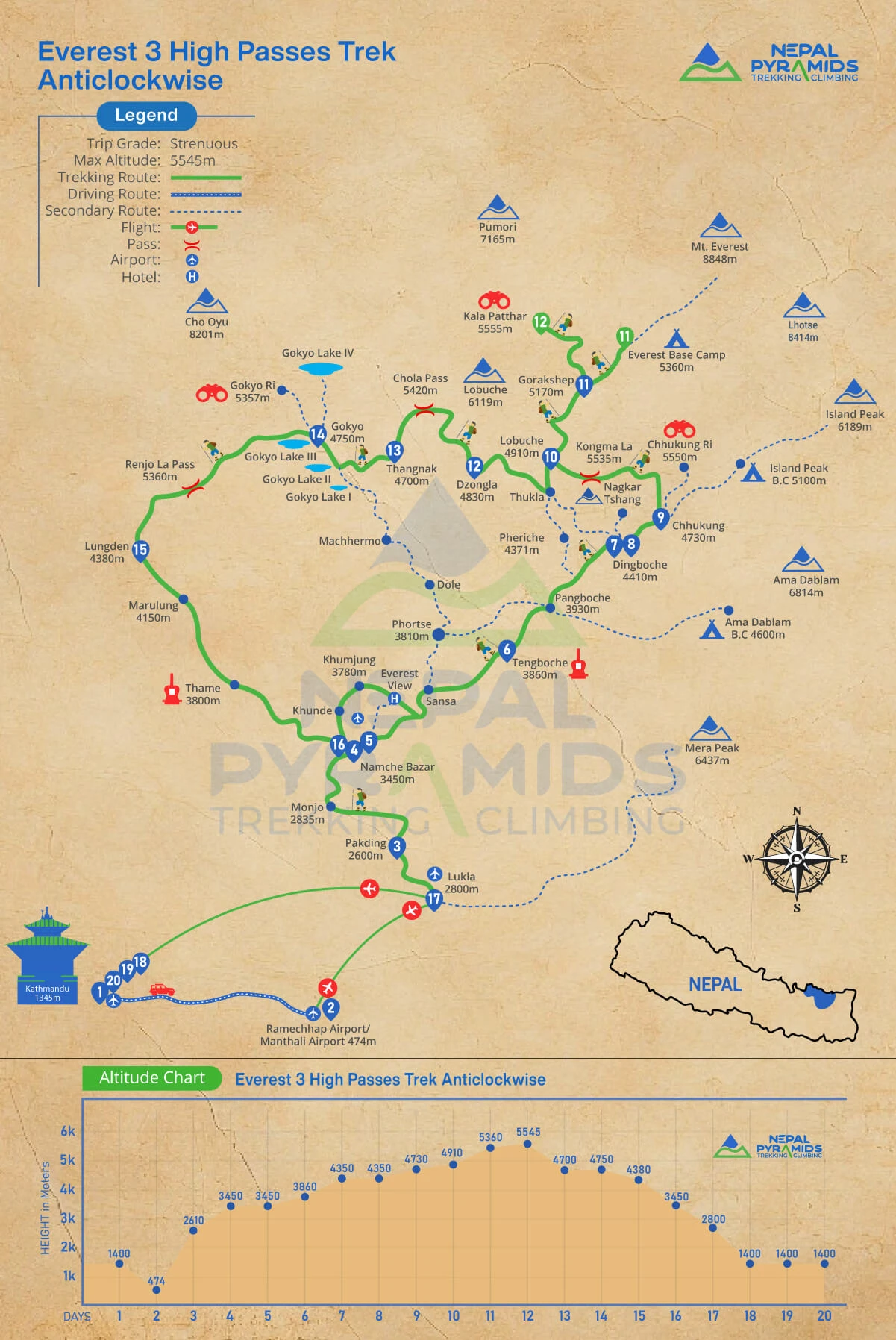Everest 3 High Passes Trek Anticlockwise Trip Highlights
The Everest 3 High Passes Trek Anticlockwise is a thrilling adventure for those seeking both natural beauty and a physical challenge in the heart of the Himalayas. It's an unforgettable experience for trekkers and mountaineers alike.
- Experience Everest from a different perspective going through the High Passes in an unconventional, anticlockwise route.
- Conquer 3 high mountain passes in the region of Everest Kongma La Pass (5,535 m), Cho La Pass (5,420m), and Renjo La Pass (5,360m).
- Witness the most stunning panoramic views of the Himalayas.
- Incredible view of 4 world's highest mountains - Mount Everest, Lhotse, Cho Oyu, and Makalu.
- Hike through 3 very prominent valleys of Everest - Everest Base Camp Valley, Gokyo Valley, and Thame Valley.
- Witness the diverse landscapes, from lush forests to alpine meadows and glacial terrain.
- Witness the rich Sherpa culture in remote mountain settlements.
- Visit the iconic Everest Base Camp, the epicenter for mountaineers' dreams.
- Walk the Ngozumpa Glacier, the longest glacier in the Himalayas.
- Enjoy the pristine Gokyo Lakes, a true paradise.
- Encounter Himalayan wildlife including Himalayan tahr, musk deer, and various bird species.
- Scenic mountain flights to and from Lukla airport.
Everest 3 High Passes Trek Anticlockwise Trip Overview:
Everest 3 High Passes Trek anticlockwise is indeed a wonderful way to explore the tranquil ambiance of the Everest region. If you are seeking an ultimate trekking experience this trip will be the right choice.
However, this 20-day package trip is not a walk in the park. Everest 3 High Passes Trek Anticlockwise falls into a STRENUOUS + + category that demands a high level of fitness. This trek is not meant for complete beginners, kids, and people with heart, respiratory, or joint issues.
This challenging high pass trek cruises through the daring 3 high passes namely - Kongma La (5535m / 18,159ft), Cho La (5,420m / 17,782ft), and Renjo La (5360m / 17,585ft) which are all over 5000 meters.
However, any Everest High Pass treks involve a tremendous amount of undulating walking which is certainly very challenging but very rewarding.
Nonetheless, it is one of the best ways to escape the regular maddening busy Everest trail. This trip is undoubtedly one of the most rewarding treks among others in the Everest Trekking Category. This 20-day 3-High Pass Trek certainly takes Travelers away from the much-occupied trail to the more serene and untouched Everest valleys.
This gorgeous trip takes you through 3 different valleys of Everest, they are Everest Base Camp Valley, Gokyo Valley, and Thame Valley. These 3 valleys are very prominent in Everest with their unique features and legends.
There was a time when all these valleys were an unexplored-untouched hidden valleys. It is said that the 1950 British Expedition team under the leadership of Eric Shipton explored these valleys. Furthermore, Edmund Hillary as well explored these hidden valleys in 1951,1952, and before summiting Everest in 1953 under the leadership of John Hunt.
In a true sense, the Everest 3 High Passes Trek has the potential to offer a better prospect for the Everest region. Furthermore, this 20-day high pass trek generates a beautiful circuit escaping the regular commercial Everest trail taking you to the serene and untouched Himalayan valleys.
Besides, Everest 3 High Passes Trek Anticlockwise is adorned with utter natural beauty which is heavenly and stays with you forever.
The Three Prominent Everest High Mountain Passes:
The Everest 3 High Passes Trek Anticlockwise includes:
- Kongma La Pass (5535m / 18,159 feet)
- Cho La Pass (5,420m / 17,782 feet) and
- Renjo La Pass (5360m / 17,585 feet)
Kongma La Pass (5535m / 18,159 feet)
Our first high Himalayan pass is Kongma La Pass (however, La itself means pass) which basically starts from Chhukhung. Chhukhung is a gateway and the last settlement to the Island peak that is located at the foot of the 4th highest mountain in the world Mt. Lhotse. However, Kongma La is typically one of the most difficult Passes in comparison to Cho La and Renjo La.
We start early today after breakfast just to get away from the harsh wind and sun. There is no settlement in between so we highly recommend carrying enough water supply. The trail cruises to the North-West from Chhukhung. The trail is a steep ascent at many points and the top of Kongma La is hidden so you hardly see the Pass until you get very close to the top.
The highlight is going over the Khumbu Glacier to get to our destination Lobuche. After Kongma La Pass we steeply descend through a slippery moraine trail down to the Khumbu glacier. Crossing this legendary glacier and getting to Lobuche is something very intriguing.
Cho La Pass (5,420m / 17,782 feet)
After Everest Base Camp and Kala Patthar, we will start retracing our trail back to Lobuche. From Lobuche, we skip the regular Everest trekking trail and enter a different valley which is very pristine. We stay overnight in the beautiful Himalayan settlement of Dzongla.
The next morning go over the mountain glacial pass, the Cho La. For this second high pass as well we start earliest in the morning. We start with an initial gradual easy trail and shortly climb all the way till we get to the glacier.
Cho La Pass usually has ice or soft snow on the top which makes it one of the most glamorous mountain passages and a very popular one in the Everest region. After the summit, we steeply descend and walk the boulder trail to the serene Himalayan meadow that eventually leads us to Dragnag.
The next day very gently we cross the Ngozumba Glacier - the longest glacier in the Himalayas. Eventually, we get to the next wondrous town of Gokyo by the magical Gokyo Lake.
Renjo La Pass (5360m / 17,585 feet)
Our final mission is to go over the highly acclaimed pass, The Renjo La. Renjo La is said to deliver one of the best views of Everest than any other high trekking point. It is certainly a vantage point that has appeased millions with its extraordinary dramatic views.
Unlike Kongma La, Renjo La is a little bit longer in distance but not as technical. Despite its longer distance walk, it is very rewarding as besides the best view it gives you the taste of real wilderness.
After the summit, we descend to a different Tibetan valley of Lumde. The Renjo La takes you to a different region of Thame. Thame is entirely different and colorful from the regular Everest trekking trail. It is believed to be the first base settlement of the Sherpas who migrated to Nepal via Nangpa La Pass. After Thame ultimately we join the regular trekking trail at Namche Bazaar.
Also, check this out :







